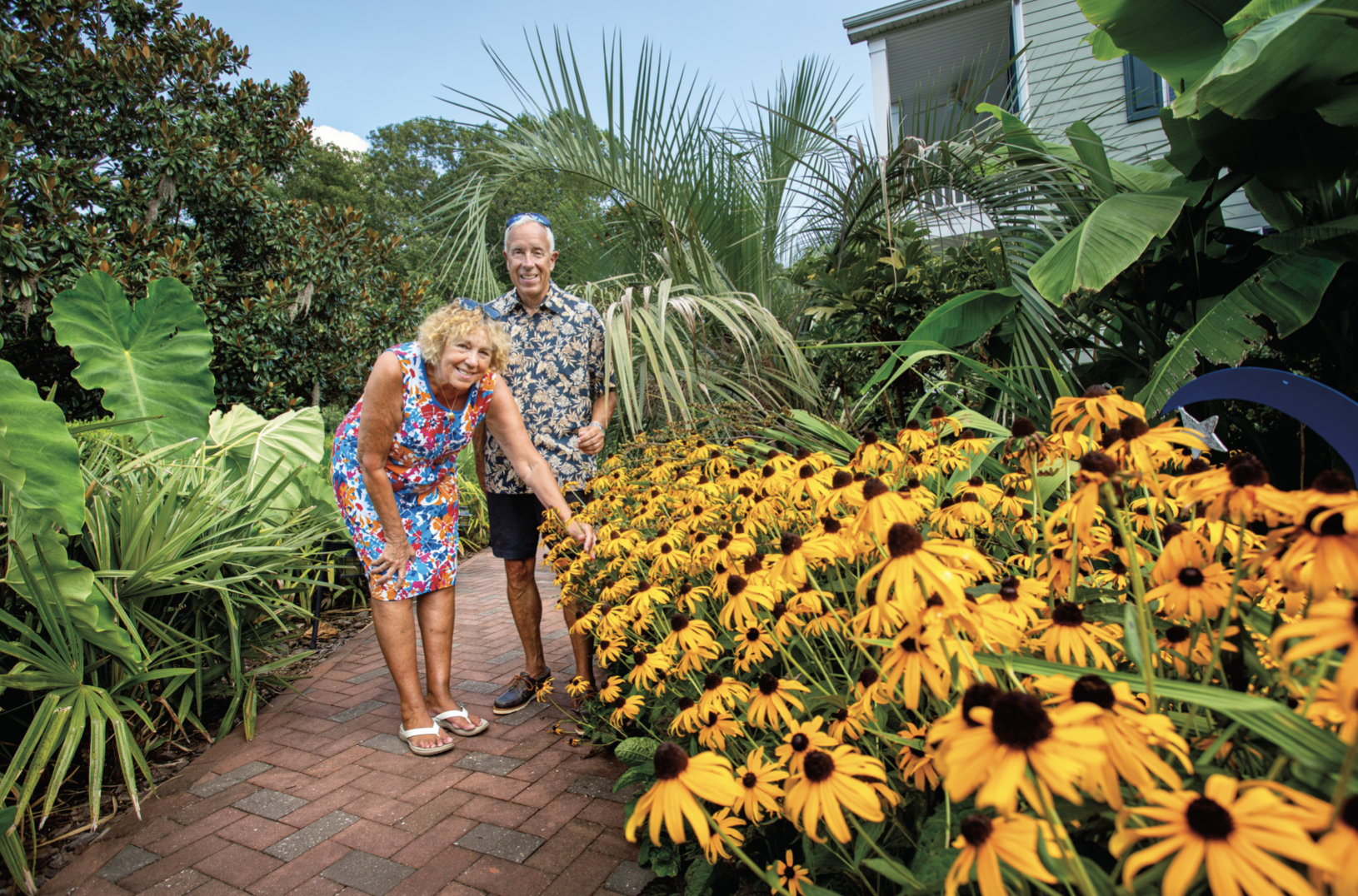
Look closely, and you’ll discover a blooming trend of backyard botanical showplaces
By Bill Newcott
Illustration by Carolyn Watson
From the October 2022 issue

“Welcome to Florida,” says Gary Smith, ushering me along the winding brick walkway that meanders from his driveway to the front door of his house.
Indeed, instead of Milton, this could just as easily be Miami. The walk is lined with pointy needle palms and shrimp plants (Justicia brandegeeana to those in the know), with their curly, pink, crustacean-like flowers. And reaching tall above them, swaying in the morning breeze, stand two windmill palm trees, the kind just about every home in Orlando has out front but, in these parts, are as rare as manatees.
Both Gary and his wife, Carol, are born-and-raised Delawareans. But, he sighs, “I’m a frustrated Floridian at heart.”
Each year the Smiths drive down to the Sunshine State for vacation, and each year they return with a carload of tropical plants that have no business being anywhere north of the Georgia state line. Then, all winter long, the two of them nurse their plants through the dark, cold months.
Take those palm trees. Smith points out to me a detail I’ve missed in my wide-eyed wonder: The trunks are covered with spirals of Christmas lights — not cold, latter-day LCD types, but the old-fashioned, heat-shedding incandescent kind.
“We tent all these tropical plants,” he says, gesturing to the assemblage of palms and citrus trees that stretch in a long, lush line around the front of the house. “Then we turn on the lights. It stays pretty warm under there.”
As someone who would somehow manage to kill a weed if it were entrusted to me, I’ve always been intrigued — and a tad intimidated — by the unique human animal known as the Gardener. In my neighborhood, I’m surrounded by such hard-working folks, who don wide-brimmed hats, get down on their knees, and against all odds manage to coax blankets of beauty from what would otherwise be a patch of unruly dirt.
Then there are those who take gardening to another level; people like the Smiths, who apparently possess some supernatural ability to conjure blooming wonderlands in their yards. To mere mortals, they are at once inspiring and infuriating; Mother and Father Natures who seem to exhale baby’s breath and, instead of footprints, leave patches of crocuses in their path.
Coastal Delaware seems to have more than its fair share of such plant-growing prodigies. I dropped in on three of them: a tropical transplanter, a floral aficionado, and an indigenous plant protagonist.
The windmill palms are the curtain raisers at the Smiths’ botanical garden, but they are decidedly just the opening act. As we round the corner of their house, Gary reaches into the lush, leafy foliage of a tree and pulls out a softball-size pink grapefruit.
Grapefruit! The only grapefruit I’ve seen since moving out of Florida 30 years ago got here by way of refrigerated rail car. And here’s a 20-foot-tall tree seemingly laden with the things.
“Actually,” Gary says, a bit apologetically, “I’ve left these on the tree way too long. We pick these all winter long; by summer they’re well past their prime. But I leave some of them on just so I can show people I grow grapefruit.”
And oranges. And lemons. All bursting with flavor during the winter; all luring the Smiths under their protective canopy for picking while the rest of us are shoveling our sidewalks. If I look closely, I can see the tiny green spheres of next winter’s crop clinging to the thin branches.
We continue our Southern sojourn with the couple pointing out just some of their notable pet plants: bird of paradise, flowering maples, elephant ears, a banana tree. As I admire a pindo palm, Carol presents me with a jar of jelly made from its fruit.
“It’s surprisingly good,” she assures me.
Gary gently lifts a massive leaf of an elephant ear, perhaps the single most aptly named member of the plant kingdom. “These things are going to grow a ton,” he says. “Mostly because I irrigate the heck out of them. In Florida, they get about an inch of rain a day.”
He’s retired from the financial world; she’s a former college bookstore director. After retiring to Milton around 2000, the Smiths at first tried to preserve their tropical plants through the cold winter months by loading them into the back of a flatbed truck and sheltering them in their garage.
“We did that for a little while, but it was exhausting,” says Gary. The Smiths then hit upon the idea of blanketing their delicate tropicals, and eventually began heating some of them with those tiny light bulbs.
It may surprise you to learn that coastal Delaware lies in USDA Plant Hardiness Zone 7b — the same zone as Atlanta and Lubbock, Texas. (Some say, with a warming climate, we may even have graduated to Zone 8 — roughly the equivalent of Tallahassee, Fla.) By comparison, Washington, D.C., just a tad farther north than us, is in Zone 7a, marginally cooler and even less hospitable to southern foliage (although the U.S. Botanic Garden, a glassed-in palace in the shadow of the Capitol dome, does boast one of the nation’s great collections of tropical and desert plants).
In 2008, the Smiths began tropical gardening in earnest. Things went surprisingly well until, in 2019, Delaware was hit with a howling polar vortex. (Before cable TV started marketing the weather, we used to call them “cold snaps.”) Safe under their tents, the citrus trees survived. But the palm trees, protected only by their spiraling lightbulbs at the time, suffered.
“We lost about seven palm trees,” says Carol. “That’s when we began to tent them.”
It’s no small deal. Each year, the Smiths rent a 55-foot lift truck to drape two layers of freeze cloth (a fabric that allows air and light to penetrate but is thick enough to retain warmth), plus a layer of plastic, over their most vulnerable tropicals. And it’s all weighed down by about 200 cinderblocks, each of them lugged into place by Gary.
“It’s a workout,” he sighs.
At a far corner of the couple’s 2-acre yard, Carol has been tending a far less flashy yet immensely more edible vegetable garden. She proudly points out the sugar snap peas, raspberries, fennel — and a single stalk of asparagus, which she promptly cuts an inch or so above ground level.
“This is delicious!” she says.
The Smiths have no help with their garden, and they wouldn’t have it any other way. And despite the hours of work involved, “it’s relaxing,” Gary says. “At night I walk out here — and, granted, the mosquitoes make me walk a little faster than I’d like — but I see all these plants, and all these flowers, and I think, ‘My gosh, I’m in Longwood Gardens!’”
Carol laughs softly to herself. “I sometimes wonder what my old friends from school would say if they saw me now,” she says. “My mom had, like, a couple of tomato plants, you know?”
Gary’s mother, on the other hand, was an accomplished gardener — and she knew exactly what her son was up against when he decided to bring Florida to Delaware. “She told me, ‘You’re going to rue the day!’” Gary recalls. Then he casts his gaze over his Milton tropical paradise.
“It’s hard to believe we take care of all this,” he says. “But we wouldn’t trade it.”
The car door opens, and I am engulfed in a cloud of fragrance. The scent of flowers, to be sure, but of no particular kind. Stepping onto the driveway, I am setting foot in a perfumery where the forgetful staff has left all the bottles open overnight.
All around me, flowers are in full bloom. I’m no horticulturalist, and I don’t know a tiger lily from a lilac. All
I know is that as I move through this space, the fragrances subtly shift from sharp to mellow; from feather light to earthy musk.
“Mostly, you’re smelling flox,” says a man in a Panama hat. He is standing at one end of a gently curving brick path that leads to the front door of his house near Lewes. A corridor of overhanging greenery frames him.
“It’s funny,” he continues, stepping forward and gently cupping a cluster of tiny, violet blossoms growing on a large leafy bush. “Most people don’t know flox is fragrant, but just take a sniff!”
He holds the tiny bouquet toward me, and I put my nose to it. The flowery fragrance, sweet and sultry, seems to roll off the blossoms.
“Flox is more popular with pollinators than any other single plant,” says the man in the Panama hat. “Nothing else blooms as much — from late June all the way ’til late October.
“Lilies, everybody likes them, but they come and go. A week or 10 days and they’re done. But the flox, it just hangs in there.”
The man in the hat is Mike Zajic, who has not come to flowers late in life. He made his career as horticultural supervisor for the Maryland-National Capital Park and Planning Commission. He also ran two world-class public gardens in Wheaton and Bethesda, Md.
Since moving to his house near Lewes full time in 2005, Mike has focused his attention on making his front, back and side yards a model garden. A couple of years after arriving, he even began cultivating the shallow lot across the street, which he also owns. The result is, in effect, a drive-through botanical park.
Some 5,000 flower enthusiasts a year wind their ways through the residential streets of Edgewater Estates to visit Mike’s little corner of paradise, incorporated as a nonprofit entity called Mill Pond Garden. Sometimes the visitors are from a garden or photography club; sometimes they’re a Philadelphia school group. Because he takes pains to plant for every season, not a day of the year goes by without some flower blossoming at Mill Pond Garden.
Mike’s biggest show of all is his holiday Garden of Lights festival, which draws 1,500 people who wander the paths among his plantings, finding new discoveries around every corner. That sense of moving from one space to another — “from room to room,” as Mike puts it — is an essential tenet of horticultural design.
“I try to show people that you don’t really need a big space to have a true garden experience,” he explains. “You just need lots of twists and turns, divisions and allées — separate rooms.”
He gestures toward the narrow roadway that separates his gardens. “We made it so that even the street is a garden.”
Frogs hop among the gurgling fountains of Mike Zajic’s world; koi jostle near the surface of a small pond, audibly sucking in air as they thrash in our direction.
“They think I’m going to feed them,” he says. “But that’s not me. My wife, Buffy, is in charge of that. She’ll be out here soon.”
He leans toward the water’s surface.“Your mama will be out here soon,” he says.
The back of the Zajics’ house presses up against Red Mill Pond. Mike has floated a pair of logs off his dock, providing a sunning spot for turtles, two of which are now taking advantage of it. As we chat, he stops to pluck some yellowing leaves from a bush.
“I can’t help myself,” he says. “All gardeners do this. They pluck as they go.”
Mill Pond Garden has five part-time employees, their salaries funded by fees paid by tour groups, event rentals and product sales. They do the heavy gardening and ladder climbing. Mike is still firmly in charge of what gets planted where.
I ask him about his first memory of gardening, and a soft smile comes across his face. He is transported back more than 70 years, to his family’s Maryland farm, stuck with a packet of nasturtium flower seeds left over from a Cub Scouts sale.
“My mother said, ‘Why don’t you plant those?’” he recalls. “Well, I had never grown anything myself. So I read the directions on the package, and I found a spot, nice and sunny. I didn’t expect much of anything. But I was amazed. It was like magic. These things grew. And they were beautiful. And I was just like, ‘Wow! I did this!’”
From that moment, young Mike Zajic had a passion for all things growing.
“I think regular food crops are beautiful, too,” he says, maybe a bit embarrassed by that admission. “I’m one of those crazy people who stops on the side of the road just to look at the ripening wheat.”
He shakes his head and laughs.
“I take pictures of ripening corn and send them to my friends.”
Mike looks me in the eye, perhaps seeking some hint that I might think he’s a tad insane. But I just smile back. The man is crazy about flowers, but he’s certainly not crazy.
Ernie Ritchey and Robert Nevrly have a Delaware garden, pure and simple. As Ernie ushers me through the garden that surrounds the married couple’s house in Spring Lake, just west of Rehoboth Beach, the words “native” and “non-invasive” crop up regularly.
Which is not to say this is a good-for-you-but-not-particularly-pretty garden. There are blossoms everywhere: brilliant yellow-and-brown black-eyed Susans, flaming red cardinal flowers, pretty pink lacecap hydrangeas, hummingbird-friendly honeysuckle. In a few weeks, his gently swaying goldenrod will be bursting with its namesake color.
Then there are all the flowering “weeds”: the fancifully named Joe Pye weed (no one is quite sure who Joe Pye was), swamp milkweed, New York ironweed, butterfly weed.
“It’s funny,” says Ernie. “All these plants have ‘weed’ in their name, and that’s because when the English moved here, they thought only their plants were the proper ones, so they called everything here ‘weed.’”
A certified master gardener specializing in native plants and residential stormwater management, Ernie had just one request when the pair moved into their house in 2017: “I didn’t want lawn,” he says. “I wanted all gardens, and I wanted to make it native — for the animals and the pollinators and the birds.”
But that vision was an ambitious one: The lot measures 12,000 square feet. And his plan involved not only flowers, but native trees, as well.
“Trees support more of our bugs and pollinators and provide more food for the birds than any other plant could ever do,” he says, showing me an Atlantic white cedar he’s planted alongside the house.
“At first we had Japanese black pines here, and they looked awesome. But then I found out they were an invasive species — you see them all along the beach now. So we cut ’em down.”
I can sense lingering regret in his tone, but a master gardener specializing in native plants has got to do what he’s got to do.
Here and there in the yard, other recently planted trees are asserting themselves: Some swamp maples overhang a cozy shade garden, a river birch stands guard near the swimming pool, loblolly pines, planted just four years ago, are thriving — as are the birds whose songs surround us.
Robert’s favorite spot in the house is the screened back porch, tucked into one corner of the house, which opens on two sides to flowers and trees.
“I sit out here and just listen to those birds,” he says. “The robins and the wrens talk, talk, talk. We’ve got cardinals and tufted titmouse — and lots and lots of hummingbirds.”
I couldn’t help but notice, lying on the ground in the garden, a copper pan.
“That was my mother’s,” says Robert. “One day I said, ‘Why don’t we put some water in it for the birds, and see what happens?’”
What happened was a thriving public bath for birds, who seem super-attracted by the combination of cool water and shiny copper. “We’ll see three or four birds in there at a time — robins, nuthatches — taking baths,” he says. “It sounds like they’re having a conversation. Then they hop up into the trees or onto the fence to flap themselves dry.
“We need to refill that pan several times a day.”
As with a lot of houses, the rain downspouts here disappear underground to feed pop-up drains. But as an expert in residential stormwater management, Ernie puts that roof runoff to good use: The pop-ups are strategically placed not only to water those gardens, but also to filter what’s left over before it leaves the property.
“The rain off your roof has lots of contaminants, which are usually nitrogen-rich,” he explains, leading me back to the front yard. “If it runs right into the gutter or body of water near your house, especially in the heat of the summer, it will contribute to algae blooms.”
But by the time rainwater has filtered through the roots of Ernie’s densely planted garden, it’s almost as clean as when it left the cloud.
On the quiet residential street, kids are riding bikes. Neighbors are chatting over their fences. I think about how nice it must be to have an oasis like this nearby, especially as, within a mile of this place, trees are being bulldozed and fields are being entombed in concrete.
“People think of native plants as weeds,” says Ernie. “What I’m trying to show everyone here is that they can also be a garden.
“A woman up the street came by, and she actually started crying. She said, ‘This is amazing. We should have done this.’
“Well, it’s not too late. You can!”



